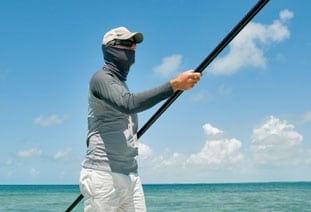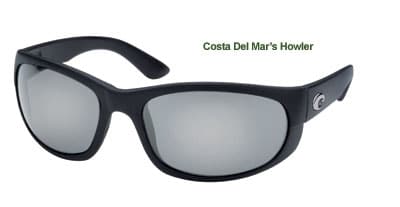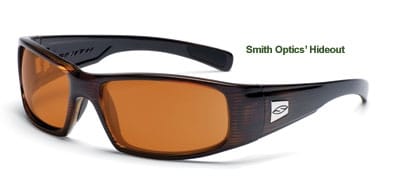
I clearly remember my first pair of polarized sunglasses. I was 16 and just getting into the sport. I had a 9-weight, two Lefty Kreh-style floppy hats (white and khaki) – even a couple Tarponwear shirts. But I hadn’t yet bought a key piece of equipment that I really needed.
Finally, I managed to stash away a few bucks and purchased a pair of Costa Del Mars in the old aviator style. For good measure, I also got some side plates and a chord to keep them safe around my neck. Watch out world – I was ready!
Flipping back through my old fishing pictures from those days, I have to laugh – those glasses were ridiculously big on my slim face! But, boy, did they keep out the sun. Better yet, they opened up a world of underwater vision throughout the waterways of southeast Florida.
Today, just like then, polarized sunglasses are of vital importance to fly anglers plying the salt. What’s more, modern technology has made them even better.
Protection and Performance
The first and foremost function of sunglasses is safety. It’s easy to underestimate the power of the sun’s ultraviolet rays, especially in tropical climates frequented by saltwater fly-fishermen. Factor in the ever-present glare off the water, and you have all the ingredients for serious eye damage. Most quality polarized sunglasses offer full protection from damaging UVA and UVB rays, but that’s not what really gets fly-fishers jazzed about their shades. Instead, it’s their polarizing qualities, which help anglers spot fish by reducing harsh glare and increasing visual acuity.

“Sunglasses don’t get as much attention as they should as far as being a key piece of equipment,” says Peter Crow, general manager of Smith Fishing, a division of Smith Optics, one of the original sunglass brands that first catered to the fly-fishing market. “Everyone focuses on rods and reels. But you’re really up a creek if you go to Christmas Island without a good pair of polarized glasses – or even a few pairs.”
Crow is right. The proper pair of glasses can make all the difference between a productive day and a poor one. When fishing the flats, lenses with brown or amber tints are generally more favorable. These lenses greatly enhance contrast, which makes underwater obstructions and bottom irregularities more visible. They also make an approaching fish stand out like a sore thumb, giving an angler and guide valuable time to deliver an effective presentation.
“But when you’re offshore, you have constant color saturation,” counters Chas MacDonald, president of Costa Del Mar, which touts its 580 polarized lens technology, which blocks harsh yellow light. “Sometimes you can see 20 feet down, but it’s a constant blue. A gray tint will give you more natural color saturation and natural contrast.”
Regardless, serious anglers should have several pairs of glasses in their arsenals for different fishing situations.
Evolving Trends
Over the last decade or so, fishing glasses have largely morphed from the old aviator style I wore as a lad to a modern wraparound look. This has negated the need for removable side plates since wraparound frames and lenses now usually provide adequate sideways protection from the sun.
The transformation in frame style also forced manufacturers to create lenses that were more curved.
“Because the frames are built for wrapping around the face, the majority of our styles have an 8-base wrap, which is basically the base curve of a lens,” MacDonald says, noting his company offers over 50 styles of frames. “This gives you coverage around the eye and on top of the eye to prevent the rays from getting in.”

Smith Fishing also uses a curved, 8-base wrap – and they take it one step further: The company thins its glass lens the closer it gets to the frames. The glass is 1.85 mm thick directly in front of the eyes but gradually thins to 1.55 mm around the edges.
“This allows your eyes to process the light coming in,” says Crow, “because when you angulate the lens, it creates distortion. The light comes in bent. Thinning the lens compensates for this; it’s harder to do, and there’s more grinding involved, but it’s much more precise.”
Smith calls this process Tapered Lens Technology (TLT), a feature that’s incorporated into each of the company’s eight fishing-specific lens tints.
Ultimately, though, it’s virtually impossible to keep all the sunlight out. And in addition to other coatings that keep lenses safe from scratches, smudges and abrasive salt, most quality sunglass manufacturers incorporate an anti-reflective (AR) coating on the inside of the lens.
“This is a very important issue,” says Rich Baum, product development manager for sunglasses at Old Harbor Outfitters. “If light gets in, the AR coating keeps it from bouncing off the lens back into your eyes.”
Indeed, modern technologies have made today’s polarized glasses serious fishing tools. But at the end of the day, it all comes down to basics.
“We certainly have a few cool-looking frames,” says Crow, “but while it’s often all about frame style in other markets, like surfing, in fly-fishing it’s about lens tint and lens quality. That’s ultimately what really matters.”
Manufacturers
Costa Del Mar
Daytona Beach, Florida
800-447-3700
www.costadelmar.com
Maui Jim
Lahaina, Hawaii
888-666-5905
www.mauijim.com
Old Harbor Outfitters
Bridgeport, Connecticut
203-540-5150
www.oldharboroutfitters.com
Smith Optics
Ketchum, Idaho
208-726-4477
www.smithoptics.com/fishing









